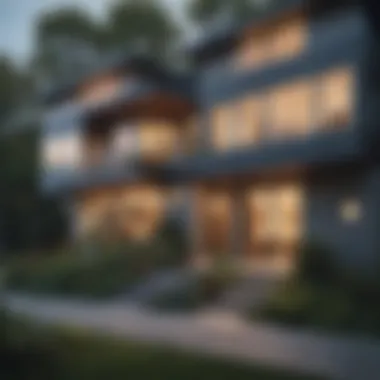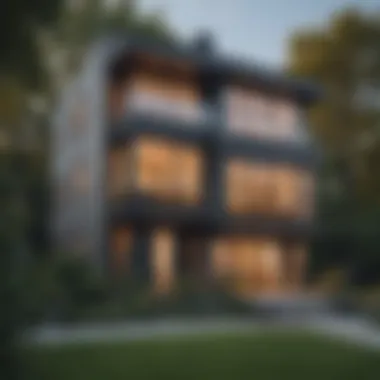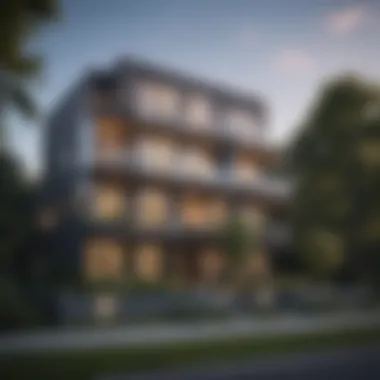Exploring Two-Unit Multi-Family Homes for Investment


Intro
The popularity of multi-family homes is gaining interest among investors, buyers, and also communities. Two-unit structures represent a unique subset within this category, providing distinct advantages. They cater to diverse lifestyles and living situations, making them appealing in today's real estate market.
This article aims to dissect various aspects of two-unit multi-family homes. Readers will find a thorough exploration of design elements, investment considerations, and how these properties affect life and community. Understanding the underlying factors is essential for anyone considering a purchase or an investment in this type of housing. This guide also emphasizes the significance of current market trends and shifts in demographics that may influence decision-making.
Featured Homes
Architectural Styles
Two-unit multi-family homes showcase an array of architectural styles. These homes often reflect the local culture and history while maintaining practicality for residents. Some notable styles include:
- Duplexes: Twin structures sharing a common wall. They can adapt traditional or modern aesthetics.
- Bungalows: Single-story designs with adjacent units, appealing for their accessibility and cozy appeal.
- Victorian-style: Often found in urban settings, these homes feature intricate details and grandeur.
Each style offers a unique blend of functionality and aesthetic appeal, making them suitable for various lifestyles.
Unique Design Elements
Design elements of two-unit homes can greatly influence their appeal and functionality. Notable features often include:
- Separate Entrances: Provide privacy and autonomy for residents, catering to different family structures.
- Shared Outdoor Spaces: These areas can foster community interactions while still offering personal space.
- Smart Home Technology: Integration of energy-efficient appliances and security systems enhances sustainability and security.
Understanding these design aspects helps potential owners appreciate the value and livability these homes provide.
Incredible Locations
Geographic Highlights
Location plays a crucial role in the viability of two-unit structures. Ideal geographical factors may include urban centers, suburban areas, and regions with robust rental markets. Key highlights often include:
- Proximity to Amenities: Being near schools, parks, and public transport contributes to desirability and accessibility.
- Emerging Neighborhoods: Areas undergoing revitalization often show potential for property value appreciation.
Potential buyers should examine these factors when evaluating properties.
Cultural Significance
Two-unit homes often reflect the cultural fabric of their locations. They accommodate diverse communities and can promote shared values among residents. Moreover, these dwellings can contribute to a rich mosaic of neighborhood interactions.
"Investing in two-unit structures not only benefits the owner but also supports community growth and cohesion."
By exploring the multifaceted aspects of ownership and living in two-unit multi-family homes, individuals can gain a clearer understanding of their potential.
Prelude to Multi-Family Homes
The interest in multi-family homes has grown recently. This interest is driven by various factors, such as the increasing cost of living and the necessity for affordable housing. Two-unit structures offer a unique solution to these challenges. They serve not only as potential income sources through rental units but also encourage a tight-knit community. Understanding this dynamic is crucial for investors and occupants alike.
Definition and Overview
Multi-family homes are residential buildings that house multiple separate units. These can range from duplexes to larger apartment complexes. A two-unit structure, specifically, is often designed with two individual living spaces, each with its own entrance and amenities. This setup can cater to families or individuals seeking companionship while maintaining a degree of separation. The versatility of these homes attracts a diverse group of buyers ranging from young couples to retirees.
The Appeal of Two-Unit Structures
Two-unit homes present unique benefits that appeal to various demographics. For those seeking affordability, sharing a structure can significantly lower living costs. From first-time buyers to seasoned investors, the prospect of generating rental income can be enticing. There are other social advantages too—shared responsibilities in upkeep and maintenance can create a sense of partnership, which is especially important in today's society.
The configuration can also enhance property values, as demand for multi-family living continues to grow. People are looking for flexible housing solutions. Furthermore, two-unit homes can lead to lower environmental impact. Their compact design often requires less land, making better use of existing urban spaces.
"Two-unit homes embody a balance between investment and community."
Understanding the factors that contribute to the viability of these structures helps homeowners and investors make informed decisions. As we delve deeper into the specifics in subsequent sections, it becomes clear that two-unit homes are more than just structures— they are a reflection of modern living.


Design Considerations for Two-Unit Homes
Design considerations for two-unit homes are vital in ensuring these structures meet the needs of their occupants while maximizing functionality and aesthetic appeal. This section discusses how thoughtful design can enhance livability, increase property value, and create harmony within the community. Key aspects include architectural styles, space utilization, and sustainable practices that contribute to the overall success of two-unit residences.
Architectural Styles and Variations
When it comes to architectural styles, two-unit homes can vary widely. They can take forms such as duplexes, townhouses, or even more modern configurations. Each style presents unique attributes appealing to different markets.
Duplex homes, for example, are often designed to look like a single-family house from the street, providing a cohesive look to the neighborhood. On the other hand, townhouses sometimes feature a more urban approach, focusing on maximizing floor space and proximity to amenities.
Incorporating regional architectural elements can also enhance appeal. In coastal areas, a two-unit home may blend design elements of beach houses with overhangs and open layouts. In contrast, urban designs might utilize sleek lines and flat roofs to better fit city landscapes.
Maximizing Space Utilization
Effective space utilization can transform how residents experience their home. In two-unit structures, it is essential to have a well-planned layout that promotes privacy while ensuring comfort. Features such as open floor plans can create an illusion of more space, while clearly defined communal and private areas enhance living conditions.
Moreover, incorporating multi-functional spaces can address the needs of varying lifestyles. For instance, a space that can function as both a living area and guest room increases the convenience of the home. Smart storage solutions are also crucial; built-in cabinets and clever use of vertical space help minimize clutter.
Sustainability in Design
Sustainability in the design of two-unit homes is increasingly essential. Not only does it align with growing environmental concerns, but it often leads to cost savings over time.
Energy Efficiency
Energy efficiency is a significant aspect of sustainable design. Implementing energy-efficient appliances, proper insulation, and smart heating systems contribute to lower utility costs and reduced environmental impact. Current trends indicate that buyers are increasingly interested in homes that support energy-saving practices. By using solar panels, high-efficiency windows, and Energy Star-rated appliances, two-unit homes can drastically lower energy consumption.
These features not only promote sustainability, but they can also qualify homeowners for various tax incentives and rebates, making them attractive investments.
Materials Selection
The selection of materials plays a crucial role in construction sustainability. Utilizing recycled or sustainably sourced materials contributes to a lower carbon footprint. For example, reclaimed wood or bamboo flooring not only offers aesthetic appeal but also showcases environmentally conscious choices.
Additionally, low-VOC (volatile organic compounds) paints and finishes minimize harmful emissions, improving indoor air quality. Such selections can lead to a healthier living environment for residents.
Choosing materials carefully can also influence long-term maintenance costs. Durable materials reduce the need for frequent replacements, ultimately benefiting homeowners financially and environmentally.
"Incorporating sustainable design principles not only enhances the value of two-unit homes but aligns them with modern buyers' preferences for environmentally responsible living."
In summary, design considerations for two-unit homes encompass a balance of aesthetics, functionality, and sustainability. By leveraging architectural variations, maximizing space utilization, and emphasizing energy-efficient materials, potential homeowners can significantly impact their investments and overall living experience.
Financial Implications
Understanding the financial implications of owning a two-unit multi-family home is essential for both potential buyers and investors. This section will detail the costs involved, financing options available, and the concept of return on investment. Each aspect contributes to a broader understanding of the financial landscape surrounding two-unit structures. The decision to invest in these properties has long-term consequences on financial stability and future growth.
Initial Costs of Two-Unit Homes
The initial costs associated with purchasing a two-unit home can be substantial. These costs typically include the purchase price, closing costs, inspection fees, and possible renovation expenses. The purchase price reflects the market value of the property, which can vary significantly based on location, condition, and demand.
Closing costs generally range from 2% to 5% of the home’s sale price. This fee covers services such as title insurance, appraisal fees, and legal services. Additionally, properties often need inspections to check for issues like structural damage or pest infestations. These inspections contribute to the initial financial outlay but are vital to ensure a good investment.
It’s wise to budget for renovation costs as well. Many two-unit homes may require updates to meet modern living standards or improve energy efficiency. Regardless of the initial financial burden, thorough planning can lead to a beneficial investment in the long run.
Financing Options Available
Different financing options can influence decisions made by buyers of two-unit homes. Understanding these options assists potential homeowners in making informed financial choices.
Conventional Mortgages
Conventional mortgages are a popular choice among buyers due to their flexibility. They often require a larger down payment, typically ranging from 5% to 20% of the home's purchase price. This can be a barrier for some, yet it results in better interest rates over time.
A key characteristic of conventional mortgages is that they are not backed by the government. This absence of backing means there may be more restrictions on who qualifies. However, this type of loan can also allow for various terms and conditions based on the lender's policies. This makes it a beneficial choice for individuals with good credit histories.


The advantage of conventional mortgages lies in potentially lower interest rates compared to government-backed loans. However, the downside may include the requirement for private mortgage insurance if the down payment is less than 20%. This additional cost can affect the overall affordability of the monthly payments.
FHA Loans
FHA loans are another financing option that many buyers consider when looking at two-unit homes. The Federal Housing Administration guarantees these loans, making them appealing especially to first-time buyers. FHA loans usually require a lower down payment, often as low as 3.5%, which opens doors for more individuals to enter the housing market.
A significant characteristic of FHA loans is that they provide more flexible credit score requirements compared to conventional loans. This means that even those with less-than-perfect credit can still qualify for homeownership. Additionally, the closing costs can be lower, making it easier to manage initial expenses.
The unique feature of FHA loans is the ability to finance some of the closing costs within the loan itself. While they come with lower initial expenses, borrowers should be aware that FHA loans require mortgage insurance premiums for the life of the loan, adding a long-term cost. These costs should be part of any financial consideration when opting for FHA loans.
Return on Investment Considerations
Investing in two-unit homes can yield substantial returns over time. The potential rental income from tenants can offset mortgage payments and contribute to a positive cash flow. This income can be particularly appealing to owners who may have one unit occupied while living in the other.
Property appreciation is another potent factor. Historically, real estate tends to appreciate over the long term, which can increase the overall value of the investment. It is crucial to consider local market trends and future development plans in the area to understand potential appreciation rates better.
In summary, the financial implications of two-unit homes encompass various aspects, from initial costs to the long-term profitability of the investment. By understanding these details, potential buyers and investors can make decisions that align with their financial goals.
A well-planned financial strategy can lead to successful ownership of multi-family homes.
Regulatory Framework for Multi-Family Homes
In the exploration of two-unit multi-family homes, understanding the regulatory framework is crucial. This framework consists of laws, codes, and policies that govern how properties are developed and maintained. Compliance with these regulations ensures that the homes are safe, livable, and in line with community standards. For potential homeowners and investors, navigating these regulations is key to making informed decisions and avoiding potential legal pitfalls.
Zoning Laws and Restrictions
Zoning laws dictate how land can be used in a specific area. They are created by local governments and can affect the type, size, and scope of multi-family developments. Here's why they are significant for two-unit structures:
- Use Restrictions: These laws may specify the types of housing permitted, determining whether two-unit homes can be built in a particular neighborhood.
- Density Restrictions: Zoning can limit the number of units allowed on a property. Understanding these limits helps in planning developments and maximizing investment.
- Setbacks: Local zoning often requires specific distances from property lines, influencing how closely homes can be situated to one another.
Potential buyers or builders should engage with local zoning boards to understand the specific regulations that apply to their intended developments.
Building Codes and Compliance
Building codes serve as a set of standards for construction practices aimed at ensuring safety and quality. Compliance with these codes is fundamental for anyone considering a two-unit home. Key considerations include:
- Structural Integrity: Codes govern the materials used and the construction techniques applied to ensure that homes are safe against environmental hazards.
- Health and Safety: Regulations often include standards for sanitation, plumbing, and electrical systems, safeguarding residents' well-being.
- Accessibility Requirements: Many codes include provisions for accessibility, which can influence the design of units to accommodate a diverse range of occupants.
In summary, understanding zoning laws and building codes provides clarity to prospective investors and homeowners. By adhering to these frameworks, individuals can ensure their two-unit homes are not only legally compliant but also contribute positively to the community.
Lifestyle Considerations
In the context of two-unit structures, the discussion of lifestyle considerations is paramount. This section focuses on how living arrangements, community dynamics, and the overall experience significantly influence both residents and potential buyers of these properties. The appeal of multi-family homes extends beyond mere financial analysis; it envelops the lived experience of inhabitants, shaping community interaction and personal relationships.
Living Arrangements and Community Dynamics
Two-unit homes provide unique living arrangements that foster a sense of community while also offering independence. The proximity of neighbors often encourages interaction, which can enhance social ties. Residents may cultivate friendly relationships with those in the adjacent unit, leading to a supportive living environment. This dynamic becomes particularly relevant for families or individuals seeking a balance between solitude and companionship.
Moreover, living in a two-unit structure facilitates shared experiences, which can manifest in various communal activities such as gardening or shared maintenance tasks. Such arrangements are increasingly appreciated, especially by individuals who value community engagement but desire a space that allows for personal retreats.
Benefits of Dual Occupancy
Lower Living Costs
Lower living costs represent a significant attraction of dual occupancy living. Sharing expenses, such as utilities and maintenance, can markedly reduce individual financial burdens. This arrangement can be particularly appealing to young professionals or families, allowing them to save money for other priorities, such as education or home upgrades. The practicality of dividing costs makes two-unit structures an attractive option in areas with rising living expenses.
A key characteristic of lower living costs lies in the shared resources, which often weigh heavily on individual budgets. The unique feature of being able to split costs demonstrates that two-unit homes can result in substantial savings over time. This affordability can enhance the attractiveness of multifamily investments, especially where property values are growing.
Shared Responsibilities


Shared responsibilities are another considerable advantage of living in a two-unit structure. This can encompass responsibilities from household chores to property maintenance duties. Sharing tasks can make managing a home more efficient. Furthermore, it establishes a collaborative atmosphere where residents rely on one another for support.
The idea of shared responsibilities can be particularly appealing to those with busy lifestyles, as it creates an environment of collaboration rather than isolated burden. On the downside, it may require clear communication and mutual understanding to navigate differences in lifestyle or expectations between occupants. However, the benefits of teamwork and lowered individual stress often outweigh possible conflicts.
Privacy Concerns and Solutions
Despite the numerous advantages, privacy remains a notable concern for residents. Living in a two-unit structure presents challenges in maintaining privacy, especially if the units share walls or outdoor spaces. Ensuring privacy can involve the installation of soundproofing measures or strategically placed landscaping to create barriers.
Potential solutions include designing layouts that prioritize separation, such as placing bedrooms away from shared common areas or creating distinct outdoor spaces. The key is to find a balance between community living and individual privacy, as both elements are vital for a harmonious life in a two-unit home.
Market Trends in Multi-Family Housing
Analyzing market trends in multi-family housing, especially concerning two-unit homes, is crucial for investors and potential homeowners. Understanding current demands and societal shifts not only helps in making informed decisions but also allows a person to forecast the viability of such investments. The multi-family home market has undergone significant changes in recent years, primarily shaped by economic conditions, demographic preferences, and lifestyle shifts. Recognizing the importance of these trends gives buyers an edge in a competitive real estate landscape.
Current Demand for Two-Unit Homes
The demand for two-unit homes has seen a notable increase in various regions. A few factors contribute to this growth:
- Affordability: With rising housing costs, two-unit structures present a more affordable option. Buyers can either occupy one unit and rent the other or share ownership with another party.
- Investment Potential: Many investors are drawn to dual-income scenarios. Owning a two-unit property can provide steady rental income, aiding in mortgage coverage and additional cash flow.
- Buyer Preferences: There is a growing trend toward multi-generational living. Two-unit homes accommodate families seeking proximity while allowing for personal space.
Statistics suggest that areas with favorable zoning laws for multi-family housing have experienced an uptick in inquiries and sales. Consequently, builders are increasingly designing two-unit homes to meet this rising demand, often incorporating modern amenities that appeal to younger demographics.
Impacts of Societal Shifts on Demand
Societal changes have significantly influenced the demand for two-unit homes. Some of the key elements include:
- Work From Home Trends: The shift towards remote work has changed housing priorities. More people desire extra space to accommodate a home office, making two-unit homes appealing for individuals who might want to split living costs while maintaining personal working spaces.
- Urban Migration: As urban areas grow, there's a trend of moving to suburban or peri-urban areas. As individuals seek homes in these regions, two-unit houses offer a feasible alternative that meets the housing demand without compromising on space or access to amenities.
- Environmental Awareness: Buyers are more conscious of sustainable living. Two-unit homes can lead to more efficient land use and less resource consumption per household, making them attractive options for environmentally-minded consumers.
"Understanding the grain of societal change is vital. It informs what developments we should pursue and helps us to craft the living experiences people want."
Real estate professionals who understand these shifts can better align their marketing strategies with the current landscape. The duality of ownership and occupancy offered by two-unit homes makes it a compelling choice for many buyers, boosting the demand in this niche of the multi-family housing market.
Challenges of Owning Multi-Family Homes
Owning multi-family homes, especially two-unit structures, presents a unique landscape of challenges. Understanding these challenges is essential for potential buyers and investors who seek to navigate the multi-family real estate market effectively. Being informed about common issues that arise can help in planning and managing a property. It is important to recognize that while there are certainly benefits, the difficulties of ownership need equal consideration.
Maintenance and Upkeep Issues
Maintenance can be a significant challenge in two-unit homes. Owners must be prepared to manage both the interior and exterior of the property. Even with just two units, the complexity of upkeep can increase. For instance, common areas may require regular cleaning and maintenance. This could include landscaping, repairs to shared facilities, and ensuring compliance with safety codes.
Another aspect of maintenance involves responding quickly to repair requests from tenants. Issues such as plumbing problems, electrical outages, or heating failures must be addressed promptly. Neglecting these matters can lead to tenant dissatisfaction, which may result in high turnover rates—ultimately affecting rental income.
Regular professional inspections can mitigate some maintenance issues. Consider scheduling seasonal checks to identify potential problems before they escalate. This proactive approach aids not only in preserving property value but also in ensuring tenant comfort.
Tenant Management and Relations
Managing tenants in a multi-family setting introduces its own set of challenges. Successful landlord-tenant relationships are vital for minimizing conflicts and maintaining a positive living environment. Every tenant has unique expectations, which can vary widely based on their previous rental experiences.
Communication plays a crucial role in tenant management. Clear, respectful dialogue ensures that tenants feel heard and valued. Problems may occasionally arise, whether due to noise complaints, disagreements over shared spaces, or differing expectations regarding property use. Having a clear set of rules and guidelines can aid in diffusing potential conflicts and establishing a harmonious community.
It is worth noting that understanding local tenant laws is essential. Familiarity with regulations protects the interests of both parties. Adhering to these laws can prevent legal complications, ensuring smoother relationships and transitions when tenants change.
The End
The exploration of two-unit multi-family homes highlights their increasing relevance in modern real estate. This section serves to consolidate the insights gathered from the previous discussions, emphasizing the practicality and strategic advantages of owning such structures. As housing markets evolve, the demand for versatile living arrangements remains strong, and two-unit homes meet this need effectively.
Summary of Key Takeaways
- Definition and Appeal: Two-unit homes offer distinct advantages, such as affordability and flexibility in living arrangements. They appeal to a range of buyers, from investors to families seeking shared space.
- Design Considerations: The layout and sustainability of these homes are critical. Thoughtful architectural choices maximize space and promote energy efficiency, making them attractive in today’s eco-conscious market.
- Financial Viability: Understanding the costs, financing options, and potential returns on investment is essential. Buyers must evaluate these factors comprehensively to make informed decisions.
- Regulatory Aspects: Being aware of zoning laws and building codes is crucial for compliance. This knowledge can save time and resources during the purchasing process.
- Lifestyle Dynamics: Two-unit homes not only provide housing but also foster community connections. They allow for dual occupancy, which can lower living costs and encourage shared responsibilities.
- Market Trends: Shifts in demographics and societal norms influence the desirability of multi-family homes. Observing these trends can guide prospective buyers and investors effectively.
Future Outlook for Two-Unit Homes
The future of two-unit homes appears promising. As urban areas grow more congested, the demand for efficient living spaces is set to rise. Key factors influencing this trend include:
- Urbanization: More people are moving to urban centers, increasing the need for affordable housing options. Two-unit structures fit this requirement well.
- Economic Factors: With rising property prices, the appeal of shared living increases. This could lead to more investments in developing two-unit properties.
- Sustainability Focus: As the emphasis on green living escalates, homes that incorporate sustainable practices will gain popularity. This aligns with the design principles of many two-unit homes today.
"In the face of ongoing economic fluctuations and shifting societal norms, understanding the viability of two-unit homes becomes essential for future buyers and investors."















